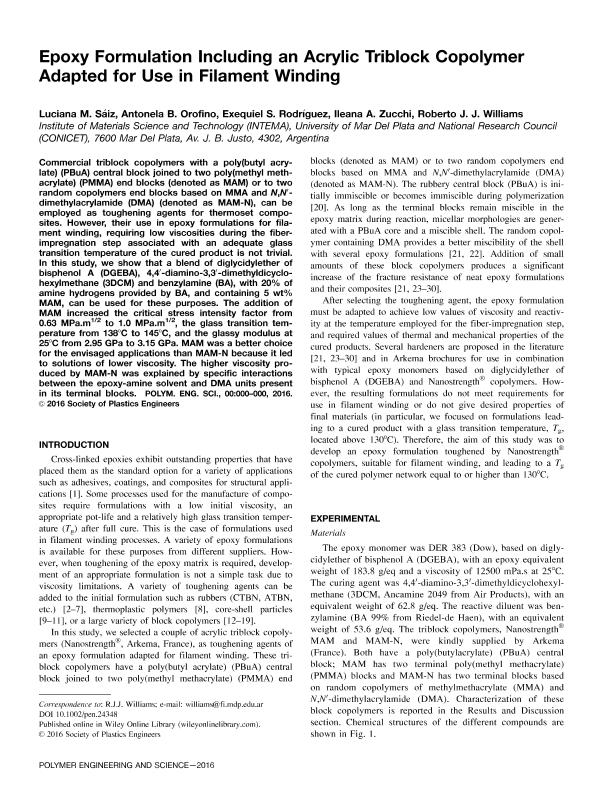Artículo
Epoxy formulation including an acrylic triblock copolymer adapted for use in filament winding
Sáiz, Luciana María ; Orofino, Antonela Beatriz
; Orofino, Antonela Beatriz ; Rodriguez, Exequiel Santos
; Rodriguez, Exequiel Santos ; Zucchi, Ileana Alicia
; Zucchi, Ileana Alicia ; Williams, Roberto Juan Jose
; Williams, Roberto Juan Jose
 ; Orofino, Antonela Beatriz
; Orofino, Antonela Beatriz ; Rodriguez, Exequiel Santos
; Rodriguez, Exequiel Santos ; Zucchi, Ileana Alicia
; Zucchi, Ileana Alicia ; Williams, Roberto Juan Jose
; Williams, Roberto Juan Jose
Fecha de publicación:
10/2016
Editorial:
John Wiley & Sons Inc
Revista:
Polymer Engineering and Science
ISSN:
0032-3888
Idioma:
Inglés
Tipo de recurso:
Artículo publicado
Clasificación temática:
Resumen
Commercial triblock copolymers with a poly(butyl acrylate) (PBuA) central block joined to two poly(methyl methacrylate) (PMMA) end blocks (denoted as MAM) or to two random copolymers end blocks based on MMA and N,N′-dimethylacrylamide (DMA) (denoted as MAM-N), can be employed as toughening agents for thermoset composites. However, their use in epoxy formulations for filament winding, requiring low viscosities during the fiber-impregnation step associated with an adequate glass transition temperature of the cured product is not trivial. In this study, we show that a blend of diglycidylether of bisphenol A (DGEBA), 4,4′-diamino-3,3′-dimethyldicyclohexylmethane (3DCM) and benzylamine (BA), with 20% of amine hydrogens provided by BA, and containing 5 wt% MAM, can be used for these purposes. The addition of MAM increased the critical stress intensity factor from 0.63 MPa.m1/2 to 1.0 MPa.m1/2, the glass transition temperature from 138°C to 145°C, and the glassy modulus at 25°C from 2.95 GPa to 3.15 GPa. MAM was a better choice for the envisaged applications than MAM-N because it led to solutions of lower viscosity. The higher viscosity produced by MAM-N was explained by specific interactions between the epoxy-amine solvent and DMA units present in its terminal blocks.
Archivos asociados
Licencia
Identificadores
Colecciones
Articulos(INTEMA)
Articulos de INST.DE INV.EN CIENCIA Y TECNOL.MATERIALES (I)
Articulos de INST.DE INV.EN CIENCIA Y TECNOL.MATERIALES (I)
Citación
Sáiz, Luciana María; Orofino, Antonela Beatriz; Rodriguez, Exequiel Santos; Zucchi, Ileana Alicia; Williams, Roberto Juan Jose; Epoxy formulation including an acrylic triblock copolymer adapted for use in filament winding; John Wiley & Sons Inc; Polymer Engineering and Science; 56; 10; 10-2016; 1153-1159
Compartir
Altmétricas



